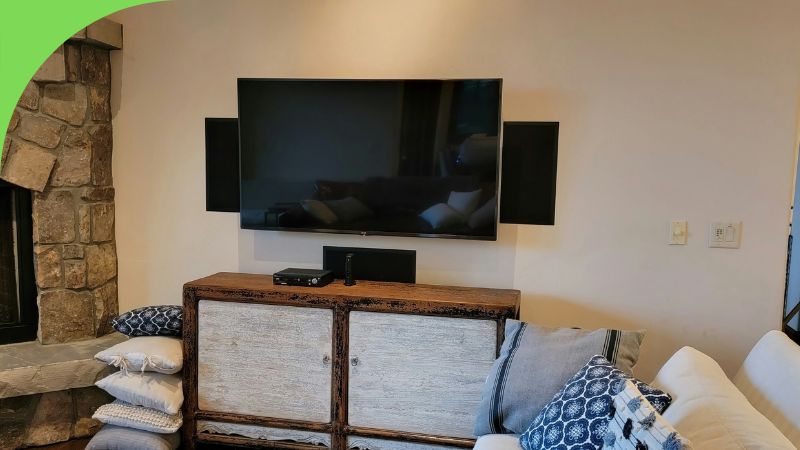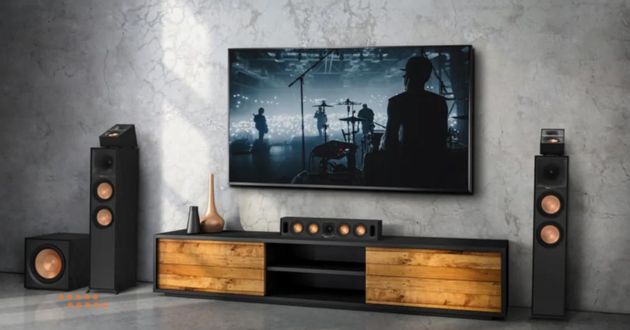Advertisements
Creating a home theater system can transform your movie-watching experience, bringing the magic of the cinema right into your living room. With the right setup, you can enjoy crisp visuals, immersive audio, and a comfortable environment that rivals any movie theater. Below, we’ll guide you through the essential steps and components needed to build an how to create a home theater system tailored to your space and budget.
1. Choose the Right Room
Selecting the Location:
- Size and Shape: Opt for a rectangular room for better sound distribution. Avoid rooms with lots of windows to reduce light interference and external noise.
- Room Acoustics: Soft furnishings and carpeted floors can improve sound quality by absorbing excessive noise.
2. Set Up the Video Display – How to create a home theater system
Choosing Your Display:
Advertisements
- Projectors: For a large, cinematic feel, a projector can cast a much larger image than most TVs. Ensure the room can be dark enough to enhance visibility.
- Televisions: A large, high-definition or 4K TV provides a clearer and brighter image, suitable for rooms with ambient light.
Display Comparison Table
| Display Type | Pros | Cons |
|---|---|---|
| Projector | Larger image, cinematic feel | Requires dark room, regular maintenance |
| Television | Brighter image, no darkness required | Smaller image compared to projectors |
3. Invest in a Sound System
Audio Components:
- Receiver: Acts as the hub through which all audio and video components connect.
- Speakers: A typical 5.1 surround sound system includes front left, right, center, two rear speakers, and a subwoofer.
- Soundbars: An alternative to multiple speakers, offering a neat setup with less wiring.
Speaker Placement Guide – How to create a home theater system
| Speaker Position | Location Guidance |
|---|---|
| Front Left/Right | Equal distance from the center, at ear level |
| Center | Directly below or above the screen |
| Rear Speakers | To the side or slightly behind the seating area |
| Subwoofer | Flexible placement, often near the front |
4. Consider Lighting and Seating
Enhancing the Viewing Experience:
Advertisements
- Lighting: Dimmable LED lights can create a theater-like ambiance. Consider blackout curtains for daytime viewing.
- Seating: Invest in comfortable seating with good back support. Recliners or dedicated theater seating can enhance the experience.
5. Integrate Streaming and Media Devices
Connecting Your Devices:
- Blu-ray Player/DVD Player: For high-quality physical media playback.
- Streaming Devices: Devices like Roku, Apple TV, or Amazon Fire Stick provide access to streaming services. Through these platforms you have access to the best streaming services for movies at the moment.
- Gaming Consoles: Can serve as both a media player and a gaming hub.
Connectivity Options Table – How to create a home theater system
| Device Type | Connectivity Options |
|---|---|
| Blu-ray/DVD Player | HDMI, Component |
| Streaming Devices | HDMI, WiFi |
| Gaming Consoles | HDMI, Optical Audio |
6. Calibration and Setup
Fine-Tuning Your System:
- Video Calibration: Adjust the display settings for optimal brightness, contrast, and color accuracy.
- Audio Calibration: Use tools like a sound meter or software to balance speaker output and fine-tune audio settings.
FAQ: How to Create a Home Theater System
Here are ten frequently asked questions (FAQs) that might help you as you plan and build your home theater system.

1. What is the best room size for a home theater?
Ideally, a medium to large rectangular room works best to accommodate audio and visual equipment and seating. Something around 20 feet long by 15 feet wide is typical, but adjust based on your available space.
2. How much does it cost to set up a home theater system?
The cost can vary widely based on choices in technology and furnishings. A basic setup might start around $1,000, but a high-end system could exceed $10,000. Set a budget early in your planning process.
3. Do I need a professional to install a home theater system?
While DIY installation is possible, hiring a professional can ensure that all components are correctly installed and optimized, which is particularly helpful for complex setups involving advanced audio and video calibration.
4. What’s the difference between a projector and a TV setup?
Projectors can provide a larger display at a potentially lower cost but require a darker room. TVs offer more brightness and clarity, and are easier to set up in rooms with ambient light.
5. Can I use a regular room lighting system?
It’s best to use dimmable lighting to control the ambiance and reduce glare on the screen. Consider blackout curtains to eliminate natural light during daytime viewing.
6. What kind of seating should I use?
Comfort is key for a home theater. Look for seating that offers good support and features like recline functions. Dedicated theater seats or sectional sofas with ample space and comfort are popular choices.
7. What is a 5.1 surround sound system?
A 5.1 surround sound system includes five speakers (left, right, center, left rear, right rear) and one subwoofer. This setup helps create an immersive audio experience by distributing sound around the viewer.
8. How do I choose the right screen size? – How to create a home theater system
The ideal screen size depends on your room size and seating arrangement. A general rule is that the screen should be big enough that its width is about half the distance from the screen to your main seating.
9. What are the best settings for audio and video calibration?
Use a video calibration disc or built-in software from your display for video settings. For audio, consider employing a decibel meter to balance speaker levels and adjusting based on listening tests from your main seating area.
10. Which is better: wired or wireless speakers? – How to create a home theater system
Wired speakers generally offer the best sound quality without any latency issues. However, wireless speakers provide a cleaner setup with fewer cables and are easier to install and rearrange if needed.
These FAQs should help you get started on your journey to creating an ideal home theater system that meets your needs and enhances your movie-watching experience.
Conclusion
Building a home theater system is a rewarding project that enhances your entertainment experience at home. By carefully selecting your equipment, setting up your space, and integrating modern technology, you can create a stunning audiovisual environment.
Remember, the key to a successful how to create a home theater system lies in balancing your preferences with the characteristics of your available space. Enjoy your new home theater!




